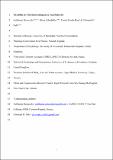Files in this item
Flexibility in wild infant chimpanzee vocal behavior
Item metadata
| dc.contributor.author | Dezecache, Guillaume | |
| dc.contributor.author | Zuberbühler, Klaus | |
| dc.contributor.author | Davila-Ross, Marina | |
| dc.contributor.author | Dahl, Christoph D | |
| dc.date.accessioned | 2021-12-02T09:34:52Z | |
| dc.date.available | 2021-12-02T09:34:52Z | |
| dc.date.issued | 2020-12-02 | |
| dc.identifier | 271187928 | |
| dc.identifier | 9b4b6177-e388-452e-a3a1-05b4871f908f | |
| dc.identifier | 000679603200003 | |
| dc.identifier | 85108369271 | |
| dc.identifier.citation | Dezecache , G , Zuberbühler , K , Davila-Ross , M & Dahl , C D 2020 , ' Flexibility in wild infant chimpanzee vocal behavior ' , Journal of Language Evolution , vol. Advance articles , lzaa009 . https://doi.org/10.1093/jole/lzaa009 | en |
| dc.identifier.issn | 2058-4571 | |
| dc.identifier.other | ORCID: /0000-0001-8378-088X/work/85167685 | |
| dc.identifier.uri | https://hdl.handle.net/10023/24468 | |
| dc.description | The research was supported by a Fyssen Fellowship, British Academy Newton International Fellowship (NF171514), and CAP2025 funding awarded to G.D., funding from the European Union’s Seventh Framework Programme for research, technological development, and demonstration (Grant agreement no. 283871) awarded to KZ the Swiss National Science Foundation (PZ00P3_154741) awarded to C.D.D., the Startup-funding of Taipei Medical University (108-6402-004-112) awarded to C.D.D., and (310030_185324) awarded to KZ | en |
| dc.description.abstract | How did human language evolve from earlier forms of communication? One way to address this question is to compare prelinguistic human vocal behavior with nonhuman primate calls. An important finding has been that, prior to speech and from early on, human infant vocal behavior exhibits functional flexibility, or the capacity to produce sounds that are not tied to one specific function. This is reflected in human infants’ use of single categories of protophones (precursors of speech sounds) in various affective circumstances, such that a given call type can occur in and express positive, neutral, or negative affective states, depending on the occasion. Nonhuman primate vocal behavior, in contrast, is seen as comparably inflexible, with different call types tied to specific functions and sometimes to specific affective states (e.g. screams mostly occur in negative circumstances). As a first step toward addressing this claim, we examined the vocal behavior of six wild infant chimpanzees during their first year of life. We found that the most common vocal signal, grunts, occurred in a range of contexts that were deemed positive, neutral, and negative. Using automated feature extraction and supervised learning algorithms, we also found acoustic variants of grunts produced in the affective contexts, suggesting gradation within this vocal category. In contrast, the second most common call type of infant chimpanzees, the whimpers, was produced in only one affective context, in line with standard models of nonhuman primate vocal behavior. Insofar as our affective categorization reflects infants’ true affective state, our results suggest that the most common chimpanzee vocalization, the grunt is not affectively bound. Affective decoupling is a prerequisite for chimpanzee grunts (and other vocal categories) to be deemed ‘functionally flexible’. If later confirmed to be a functionally flexible vocal type, this would indicate that the evolution of this foundational vocal capability occurred before the split between the Homo and Pan lineages. | |
| dc.format.extent | 1373537 | |
| dc.language.iso | eng | |
| dc.relation.ispartof | Journal of Language Evolution | en |
| dc.subject | BF Psychology | en |
| dc.subject | NDAS | en |
| dc.subject.lcc | BF | en |
| dc.title | Flexibility in wild infant chimpanzee vocal behavior | en |
| dc.type | Journal article | en |
| dc.contributor.institution | University of St Andrews. Institute of Behavioural and Neural Sciences | en |
| dc.contributor.institution | University of St Andrews. Centre for Social Learning & Cognitive Evolution | en |
| dc.contributor.institution | University of St Andrews. School of Psychology and Neuroscience | en |
| dc.identifier.doi | 10.1093/jole/lzaa009 | |
| dc.description.status | Peer reviewed | en |
| dc.date.embargoedUntil | 2021-12-02 |
This item appears in the following Collection(s)
Items in the St Andrews Research Repository are protected by copyright, with all rights reserved, unless otherwise indicated.

